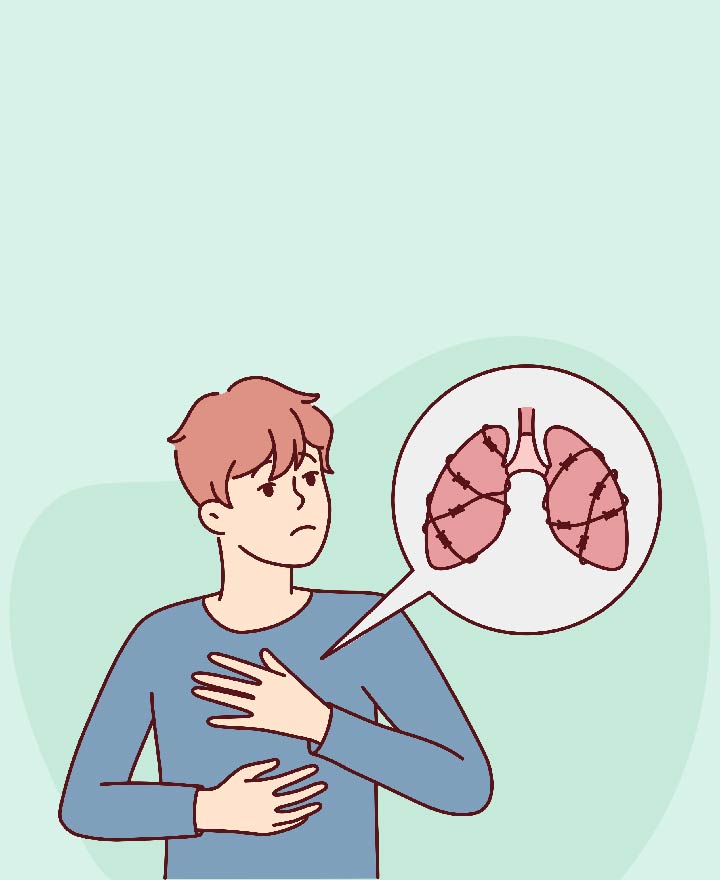

Pneumonia: Types, Symptoms and Causes
Pneumonia is an infection that inflames the air sacs in one or both lungs. It can range in seriousness from mild to life-threatening. There are several symptoms that can help you detect the pneumonia and get started with the treatment process. Read on to take a detailed look at some of the most common pneumonia symptoms, causes and risk factors.
Types of Pneumonia
Based on the types of germs that cause it and where you got the infection, pneumonia is classified
• Community-acquired pneumonia (CAP)
This is the most common type of pneumonia which occurs outside a healthcare or hospital facility.
• Hospital-acquired pneumonia (HAP)
This includes cases that have been acquired during a hospital stay for another illness.
• Aspiration pneumonia
This includes cases that have been acquired when drink, food, saliva, or vomit go down your windpipe and into your lungs.
• Ventilator-associated pneumonia (VAP)
This includes cases of pneumonia acquired by individuals after being on mechanical ventilation for more than 48 hours.
• Healthcare associated pneumonia (HCAP)
This includes cases that have been acquired while in a long-term care facility or in extended-stay clinic.
Symptoms
Pneumonia symptoms are often similar to flu or cold but they stay for a longer duration. The seriousness of the infection varies from case to case, generally depending on the causing agent & patient’s health condition and age. This is why identifying pneumonia symptoms are very important.
Common symptoms include:
• Fatigue
• Difficulty in breathing
• Cough (dry or may produce thick phlegm)
• Below normal body temperature
• Feelings of being unwell
• Loss of appetite
• Pain in chest
• Increased heartbeat
• Fever, shivering and sweating
• Nausea
• Abrupt changes in mental state
• Headaches
Apart from these, less common symptoms include muscle and joint pain, haemoptysis, wheezing, etc. In case of newborns or infants, the signs of pneumonia may or may not reflect, so make sure to consult a doctor if you suspect anything wrong.
Causes
Many bacteria, viruses and fungi can cause the infections that lead to pneumonia. Bacteria are the most common cause in adults and viruses are the most common cause in school-aged children. Common illnesses that can lead to pneumonia include:
• Common cold (rhinovirus).
• COVID-19 (SARS-COV-2).
• The flu (influenza virus).
• Human metapneumovirus (HMPV).
• Human parainfluenza virus (HPIV).
• Legionnaires’ disease.
• Mycoplasma pneumonia bacteria.
• Pneumococcal disease.
• Pneumocystis pneumonia.
• Respiratory syncytial virus (RSV).
Risk Factors
Pneumonia can affect anyone, but two age groups that are at highest risk are children aged 2 years or younger and people who are age 65 years and older. Other factors include:
• Individuals with certain types of chronic health conditions, like asthma, COPD, diabetes, heart failure, cystic fibrosis, sickle cell disease, kidney disease, liver disease
• Individuals with weakened immune systems caused by HIV, pregnancy or due to use of specific medications, such as cancer drugs or steroids
• Individuals with a brain disorder like stroke, Parkinson’s disease, dementia, head injury, etc. which can affect the ability to cough or swallow
• Individuals currently under active hospitalisation, especially if they are on a ventilator
• Individuals who are regularly exposed to harmful lung irritants like toxic fumes, polluted air, etc.
• Individuals with daily smoking habits, which make it more difficult for their bodies to get rid of the mucus from their airways
• Individuals living within a highly populated environment, such as a nursing home, prison and so on
• Individuals with weakened immune systems due to excessive drinking. The probability of inhaling liquid or food into the lungs also increases under alcoholic influence.
Conclusion
With so many causes and varying symptoms, pneumonia can feel confusing. Consult your doctor immediately if you experience any above mentioned symptoms.
One of the important components of our overall wellness is also being financially secured. Healthcare emergencies can happen any time, but a good health insurance policy can protect you from such uncertain situations. To know more about it, click here.
Source: Mayoclinic, Healthline, MedicalNewsToday
Disclaimer: This blog provides general information and discussions about health and related subjects. The information and other content provided in this blog, website or in any linked materials are not intended and should not be considered, or used as a substitute for, medical advice, diagnosis or treatment. Kindly contact your Doctor before starting a new medicine or health regime.
Related Articles
10 diseases caused by water pollution
Common nutritional problems in India
World Pneumonia Day – Important Tips to Stay Safe from Pneumonia
Common Winter Health Issues and Tips to Keep Them at Bay
Published on August 17, 2023


 Health Insurance
Health Insurance  Travel Insurance
Travel Insurance  Car Insurance
Car Insurance  Cyber Insurance
Cyber Insurance  Critical Illness Insurance
Critical Illness Insurance
 Pet Insurance
Pet Insurance
 Bike/Two Wheeler Insurance
Bike/Two Wheeler Insurance  Home Insurance
Home Insurance  Third Party Vehicle Ins.
Third Party Vehicle Ins.  Tractor Insurance
Tractor Insurance  Goods Carrying Vehicle Ins.
Goods Carrying Vehicle Ins.  Passenger Carrying Vehicle Ins.
Passenger Carrying Vehicle Ins.  Compulsory Personal Accident Insurance
Compulsory Personal Accident Insurance  Travel Insurance
Travel Insurance  Rural
Rural